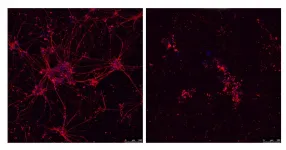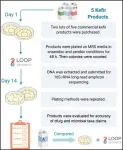(Press-News.org) In Amyotrophic Lateral Sclerosis (ALS), the progressive death of neurons that control body movement leads to paralysis of muscles in the limbs and gradually of the whole body, which ultimately makes it impossible to breathe. ALS is currently untreatable, and its cause is unknown.
It is known, however, that in 10% of affected individuals there is a strong genetic component, which causes the disease to occur in several members of a single family. In about half of these cases of familial ALS, the origin lies in a gene called C9ORF72. But why do mutations in this gene kill motor neurons?
The answer may have been found by the Genomic Instability Group headed by Óscar Fernández-Capetillo at the Spanish National Cancer Research Centre (CNIO), who discovered a mechanism that explains the toxicity derived from mutations in C9ORF72. The novel mechanism links these mutations to a general problem that blocks all nucleic acids, DNA and RNA, and thus disrupts a multitude of processes that are fundamental to the functioning of cells.
The paper is published this week in The EMBO Journal, with CNIO researchers Vanesa Lafarga and Oleksandra Sirozh as first authors.
Why neurons die in ALS patients
ALS researchers had already observed that many basic cellular processes that use nucleic acids do indeed fail in the neurons of affected patients. Now the CNIO group provides a model that connects them all and thereby explains these widespread problems.
"I think we have a pretty satisfactory model that helps us understand what is going on in the motor neurons of ALS patients, what is killing them," says Fernández-Capetillo. "We are excited, as the key to curing any disease is to understand first what is not working. Only then can you start looking for a treatment."
Although the newly identified toxic mechanism is associated with mutations in a specific gene, C9ORF72, the CNIO group believes it is likely that other ALS-related mutations are acting in a similar way, i.e., by blocking the DNA and RNA of motor neurons.
Too much arginine
Mutations in the C9ORF72 gene are toxic, the CNIO researchers reveal, because they induce the cell to produce small proteins or peptides that are very rich in arginine, an amino acid that, due to its positive charge and chemical nature, binds very avidly to nucleic acids, DNA and RNA.
The CNIO study indicates that, by binding to nucleic acids with such high affinity, these arginine-rich proteins displace all cellular proteins that interact with DNA and RNA in a widespread manner, thus blocking any cellular reaction that involves DNA or RNA. And as a result, with its nucleic acids effectively blocked, the cell dies.
DNA contains the instructions for the cell to make the proteins it needs for proper function. Hundreds of proteins need to anchor themselves to the DNA and RNA to read their instructions and eventually make new components for the cell. But "the presence of arginine-rich peptides hampers any reaction involving nucleic acids," the authors of the new study add.
As Fernández-Capetillo puts it: "What we have seen is that arginine-containing peptides are like a kind of tar that sticks to nucleic acids and decorates them, and in doing so they displace the proteins that are normally bound to the nucleic acids so that nothing that involves DNA or RNA works."
Eureka moment
"In all these decades of ALS research, neuroscience researchers have been publishing all sorts of problems in reactions using nucleic acids: translation, replication, etc. Nothing works! We think our model gives a simple answer to all these observations," continues Fernández-Capetillo.
Fernández-Capetillo's research usually focuses on cancer, but he strives to "keep his eyes open" to any problem to which his knowledge can be applied. In 2014, he started working on ALS, convinced that a technique recently established in his group could help them understand the toxicity of mutations in the C9ORF72 gene. And it was a flash of insight, an idea that came up after having coffee at the CNIO with Nobel laureate Jack Szostak, which put him on the trail of arginine.
"Szostak investigates the chemistry of the origin of life, and he told me that to stop reactions involving nucleic acids what they used in their experiments was precisely synthetic peptides with lots of arginines because of their high affinity for nucleic acids," says Fernández-Capetillo. "So I thought, what if this is what is going on, what if the arginine-rich proteins in ALS patients are blocking DNA and RNA in a generalised way?"
The protein that compacts sperm nucleus does the same thing
This initial hypothesis was supported when the group decided to test whether similar problems were also seen when cells would be exposed to a natural protein that has a lot of arginines. There is such a protein, but it is expressed only transiently during the development of sperm cells: protamine.
Consistent with the model now published in The EMBO Journal, the biological function of protamine is to displace histones from the DNA; histones are proteins that facilitate DNA compaction. "By exchanging histones for protamine, which is smaller, sperm DNA can become more compact," explains Fernández-Capetillo.
However, protamine is toxic to any cell that is not a sperm cell. "We think that what happens in ALS patients is equivalent to what would happen if their motor neurons accidentally started to produce protamine."
Indeed, the paper in The EMBO Journal shows that the cellular effects of protamine are identical to those of the arginine-rich peptides found in ALS patients.
How to overcome toxicity
Now that we understand why arginine-rich peptides are toxic, the next step is to find ways to overcome this toxicity. And research along these lines has already begun in the group. As has the work to create animal models in which the problem - the production of toxic peptides - is reproduced, to provide a platform for testing potential therapies.
Learning how to alleviate the toxicity of these peptides may also be useful in addressing non-C9ORF72-associated ALS, that is, the disease as a whole. The authors of the paper believe that the widespread mechanism of nucleic acid blocking is probably what happens in ALS in general.
As Vanesa Lafarga explains, "the vast majority of mutations found in ALS patients are in proteins that bind RNA, and what these mutations generally do is prevent the binding of these proteins to RNA. Moreover, the cells of these patients also have very general problems with their nucleic acids. That is why we believe that, although mutations in C9ORF72 only affect a fraction of ALS patients, the mechanism underlying the toxicity of neurons may not be fundamentally different from what happens in the rest of ALS patients. Trying to show whether this is the case is something we are working on now."
INFORMATION:
This work has been funded by the Spanish Ministry of Science and Innovation, the National Institute of Health Carlos III, the Botín Foundation, Banco Santander through Santander Universities, the European Research Council and Deutsche Forschungsgemeinschaft.
Reference article: Widespread displacement of DNA- and RNA-binding factors underlies toxicity of arginine-rich cell-penetrating peptides. V. Lafarga et al (The EMBO Journal, 2021). DOI: 10.15252/embj.2019103311
The property that makes fluorescent lights buzz could power a new generation of more efficient computing devices that store data with magnetic fields, rather than electricity.
A team led by University of Michigan researchers has developed a material that's at least twice as "magnetostrictive" and far less costly than other materials in its class. In addition to computing, it could also lead to better magnetic sensors for medical and security devices.
Magnetostriction, which causes the buzz of fluorescent lights and electrical transformers, occurs when a material's shape and magnetic field are linked--that is, a change in shape causes a change in magnetic field. The property could be key to a new generation of computing devices called ...
Trained to see patterns by analyzing thousands of chest X-rays, a computer program predicted with up to 80 percent accuracy which COVID-19 patients would develop life-threatening complications within four days, a new study finds.
Developed by researchers at NYU Grossman School of Medicine, the program used several hundred gigabytes of data gleaned from 5,224 chest X-rays taken from 2,943 seriously ill patients infected with SARS-CoV-2, the virus behind the infections.
The authors of the study, publishing in the journal npj Digital Medicine online May 12, cited the "pressing need" ...
The 'missing link' that helped our ancestors to begin communicating with each other through language may have been iconic sounds, rather than charades-like gestures - giving rise to the unique human power to coin new words describing the world around us, a new study reveals.
It was widely believed that, in order to get the first languages off the ground, our ancestors first needed a way to create novel signals that could be understood by others, relying on visual signs whose form directly resembled the intended meaning.
However, an international research team, led by experts from the University of Birmingham and the Leibniz-Centre General Linguistics (ZAS), Berlin, have discovered that iconic ...
Lancaster scientists have demonstrated that other physicists' recent "discovery" of the field effect in superconductors is nothing but hot electrons after all.
A team of scientists in the Lancaster Physics Department have found new and compelling evidence that the observation of the field effect in superconducting metals by another group can be explained by a simple mechanism involving the injection of the electrons, without the need for novel physics.
Dr Sergey Kafanov, who initiated this experiment, said: "Our results unambiguously refute the claim of the electrostatic field effect ...
Touchscreens are notoriously difficult to type on. Since we can't feel the keys, we rely on the sense of sight to move our fingers to the right places and check for errors, a combination of efforts we can't pull off at the same time. To really understand how people type on touchscreens, researchers at Aalto University and the Finnish Center for Artificial Intelligence (FCAI) have created the first artificial intelligence model that predicts how people move their eyes and fingers while typing.
The AI model can simulate how a human user would type any sentence on any keyboard design. It makes errors, detects them -- though not always immediately -- and corrects them, very much like ...
Philadelphia, May 12, 2021 - The COVID-19 pandemic has resulted in an abrupt change in healthcare delivery, including a shift from in-person visits to telemedicine. However, a Canadian survey found that a significant proportion of cardiology trainees are uncomfortable with using telemedicine and feel that better preparation for new-tech medicine is needed. Experts draw attention to the need for a telemedicine curriculum that includes supervision to prepare trainees for the expanding role of telemedicine in cardiovascular care. Survey results are published in the Canadian Journal of Cardiology.
"Our outpatient care shifted almost overnight from in-person visits to providing care to patients via telephone or video platforms (known as telemedicine) as a result ...
Philadelphia, May 12, 2021 - In recent years there has been an increased interest in the consumption of kefir, a fermented dairy beverage, because there is some evidence that it has health benefits and its affordability. A new study by researchers from the University of Illinois and The Ohio State University, published in JDS Communications, found that 66 percent of the commercial kefir products studied overstated microorganism density and 80 percent contained bacterial species that were not included on the label, potentially misleading consumers.
Senior author Kelly S. Swanson, PhD, University of Illinois, Urbana, ...
A new study led by the Centre for Nutraceuticals in the University of Westminster shows that pink drinks can help to make you run faster and further compared to clear drinks.
The researchers found that a pink drink can increase exercise performance by 4.4 per cent and can also increase a 'feel good' effect which can make exercise seem easier.
The study, published in the journal Frontiers in Nutrition, is the first investigation to assess the effect of drink colour on exercise performance and provides the potential to open a new avenue of future research in the field of sports drinks and exercise.
During the study participants were asked to run on a treadmill for 30 minutes at a self-selected speed ensuring their rate of exertion remained consistent. Throughout the exercise ...
For college students under pressure, a dog may be the best stress fighter around.
Programs exclusively focused on petting therapy dogs improved stressed-out students' thinking and planning skills more effectively than programs that included traditional stress-management information, according to new Washington State University research.
The study was published today in the journal AERA Open, a peer-reviewed journal of the American Educational Research Association. The paper demonstrated that stressed students still exhibited these cognitive skills improvements up to six weeks after completion of the four-week-long program.
"It's a really powerful finding," said Patricia Pendry, associate professor in WSU's Department of ...
Researchers from University of Maryland, North Carolina State University, National Taiwan University, Oxford University, Kings College London, and Perceptronics Solutions, Inc. published a new paper in the Journal of Marketing that examines how artificial intelligence (AI)-based text analysis of social media can monitor the extent to which brand reputation rises and falls over time.
The study, forthcoming in the Journal of Marketing, is titled "Real-Time Brand Reputation Tracking using Social Media" and is authored by Roland Rust, William Rand, Ming-Hui Huang, Andrew Stephen, Gillian Brooks, ...




